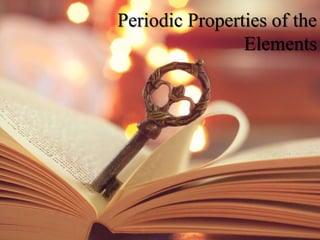
Periodic properties of the elements
- 1. Periodic Properties of the Elements
- 2. Atomic radius Atomic radius is generally stated as being the total distance from an atom’s nucleus to the outermost orbital of electron. In simpler terms, it can be defined as something similar to the radius of a circle, where the center of the circle is the nucleus and the outer edge of the circle is the outermost orbital of electron. As you begin to move across or down the periodic table, trends emerge that help explain how atomic radii change.
- 3. .
- 4. Ionization Energy Expelling an electron from an atom requires enough energy to overcome the magnetic pull of the positive charge of the nucleus. Therefore, ionization energy (I.E. or I) is the energy required to completely remove an electron from a gaseous atom or ion. The Ionization Energy is always positive
- 5. . The energy required to remove one valence electron is the first ionization energy, the second ionization energy is the energy required to remove a second valence electron, and so on. • 1st ionization energy Na(g)→Na+(g)+e−(g) • 2nd ionization energy Na+(g)→Na2+(g)+e−
- 6. .
- 7. Electron Affinity Electron affinity (E.A.) is the energy change that occurs when an electron is added to a gaseous atom. Electron affinity can further be defined as the enthalpy change that results from the addition of an electron to a gaseous atom. It can be either positive or negative value. The greater the negative value, the more stable the anion is
- 8. .
- 9. Electronegativity Electronegativity is the measurement of an atom to compete for electrons in a bond.The higher the electronegativity, the greater its ability to gain electrons in a bond. Electronegativity is related with ionization energy and electron affinity.Electrons with low ionization energies have low electronegativities because their nuclei do not exert a strong attractive force on electrons. Elements with high ionization energies have high electronegativities due to the strong pull exerted by the positive nucleus on the negative electrons. Therefore the electronegativity increases from bottom to top and from left to right.
- 10. .
- 11. Metallic Character The metallic character is used to define the chemical properties that metallic elements present. Generally, metals tend to lose electrons to form cations. Nonmetals tend to gain electrons to form anions. They also have a high oxidation potential therefore they are easily oxidized and are strong reducing agents. Metals also form basic oxides; the more basic the oxide, the higher the metallic character.
- 12. .
- 13. Summary
- 14. . Thank u ppt by- Tarun Sharma
